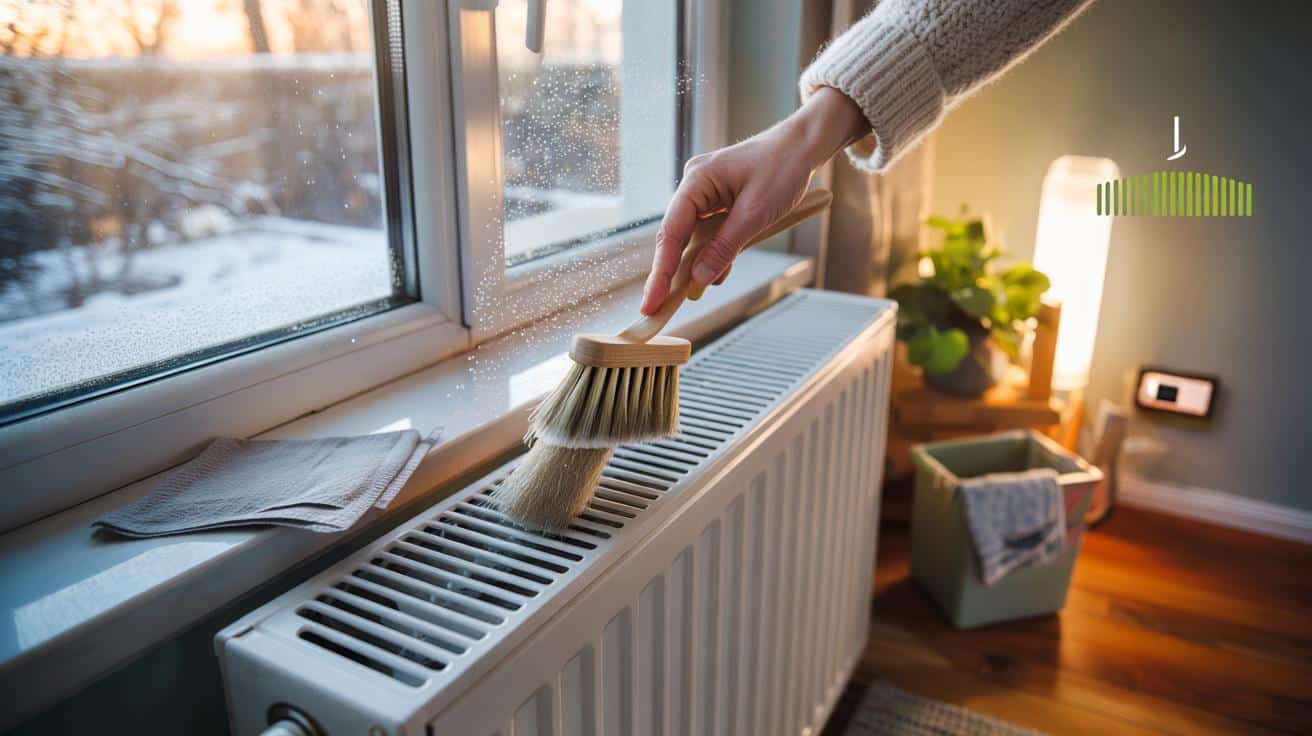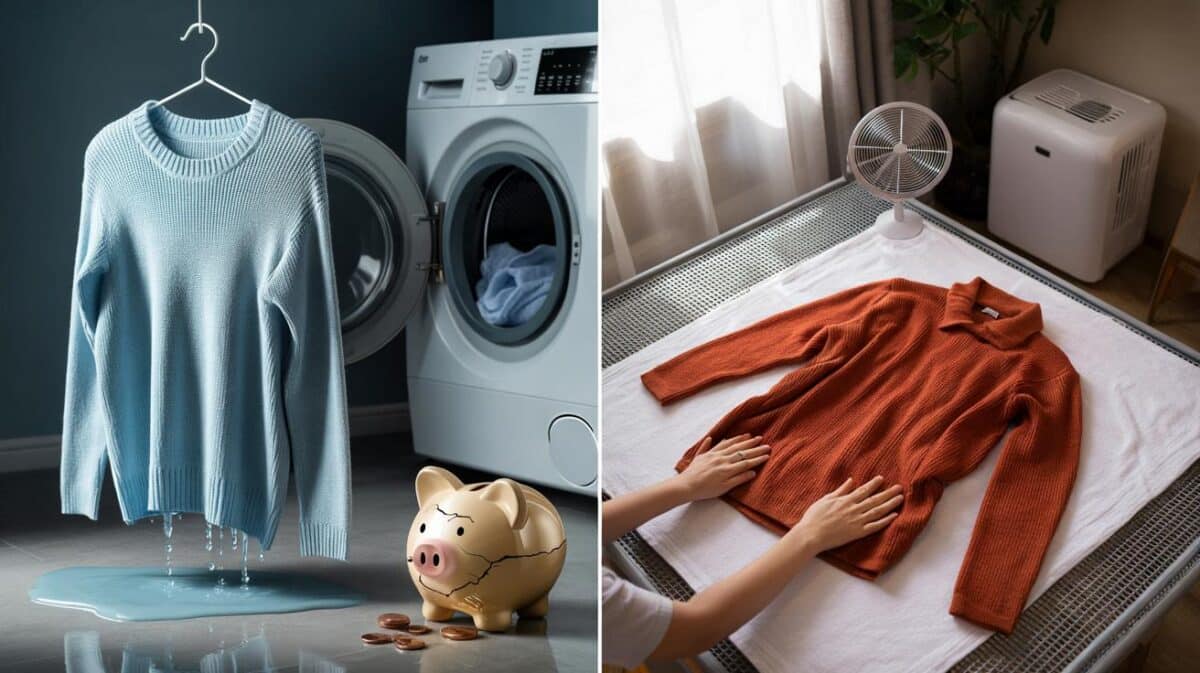The fix is cheap, quick and oddly satisfying.
As heating snaps back on, radiators turn into quiet dust engines. Fibres, pet dander and fluff gather in fins, then lift with warm air. People with allergies notice first. Parents, tenants and home-workers feel it next: stale smells, tickly throats, dingy shelves hours after cleaning.
Radiators, the dust traps you forget
Unlike shelves, radiators hide their mess in vents and behind panels. Convection drags particles inside whenever the heating runs. Warm air then carries them out again. Brush the surface and you stir a cloud you cannot see, only sniff and sneeze at.
That fuzz does more than offend the eye. Dust works like a thin coat of insulation. Heat transfer falls. The boiler or electric element runs longer to hit the same set-point. In small rooms with convector panels, a heavy build-up can knock comfort, raise bills and leave that faint “hot dust” odour.
Warm airflow turns each fin into a tiny blower. Disturb it carelessly and you launch a micro-dust storm across the room.
The damp kitchen paper trick: how it stops dust in its tracks
There is a cleaner’s shortcut that keeps particles down where they belong. Place a sheet of lightly damp kitchen paper on the top of the radiator. Then brush from the vents downward. Dust drops. The paper grabs it. You lift and bin. No plume, no second clean.
Step by step, from cool radiator to clean fins
- Switch the radiator off and let it cool. You want warm, not hot.
- Wring one to two sheets of kitchen paper under the tap until just damp. No drips.
- Lay the paper across the top grille or along the open edge. Cover the length.
- Use a soft paintbrush or a dedicated radiator brush. Sweep inside the fins with short, gentle strokes, moving downward.
- As dust falls, it lands on the damp sheet and sticks. Do not rush. Let gravity help.
- Lift the paper by the corners and fold it onto itself. Bin it immediately.
- Finish with a lightly damp microfibre on the front panel and vertical edges.
Place, brush, lift, bin: one tidy loop that captures dust instead of spreading it around the house.
Time, cost and payoff
The kit costs pennies. Two sheets and a mug of water will do. One average double-panel radiator takes four to six minutes. Seven radiators across a small home add up to roughly forty minutes once a fortnight. In exchange, you cut airborne particles, reduce that scorched smell and help the system deliver heat more comfortably.
| Method | Airborne dust | Risk to finish | Typical cost per session | Notes |
|---|---|---|---|---|
| Damp kitchen paper + soft brush | Low | Low | £0.02–£0.05 | Captures dust where it falls; quick set-up |
| Feather duster | High | Low | £0 | Moves dust into the room, needs repeat cleaning |
| High-power vacuum | Medium–High | Medium | £0 | Stirs airflow; can scuff paint and loosen fins |
| Sprays and wipes | Medium | Medium | £0.10–£0.50 | Adds fragrance; moisture can reach electrics if misused |
How often should you do it
In autumn, give each radiator attention every two to four weeks. During a cold snap, check children’s rooms weekly. After decorating, drill work or a pet’s shedding phase, run the method immediately. Short, regular sessions beat one long slog in March.
Mistakes to avoid
- Do not blast with a hairdryer, compressed air or a vacuum on max. You redistribute the problem.
- Avoid abrasive pads, metal brushes and harsh detergents. They scar paint and invite faster soiling.
- Keep water away from electrics. Damp, not wet. Never drip into an electric convector or panel heater.
- Do not clean while hot. Heat dries the paper and bakes residue onto surfaces.
What about different radiator types
Panel convectors with top grilles: the method shines here. Slide the brush between fins from top to bottom while the paper covers the grille.
Column radiators: wrap the damp sheet along the top rail in sections. Brush between columns from top to floor with slow strokes.
Towel rails: run a narrow strip of paper along the highest bar. Brush down behind, then wipe the uprights.
Electric panel heaters: switch off at the wall and let them cool fully. Use very lightly damp paper and avoid pushing moisture into vents. If in doubt, stick to a dry microfibre and a HEPA vacuum held below the airflow on low power while you brush.
Any heater with electrics needs a cool surface, a light touch and moisture control. When unsure, keep it dry.
Why it feels better to breathe after
Dust is a cocktail of fibres, skin flakes, pet dander and soot-like particles. Warm currents lift it to breathing height. Sensitive noses pick up the change after a clean: fewer irritants, fewer odours and less haze in sunbeams. Bedrooms benefit quickly because nighttime airflow is gentle and persistent.
There is also an efficiency angle. Dust-laden fins pass heat less effectively. In convector-style designs, testing shows that significant deposits can cut heat transfer by double digits under lab conditions. Real homes vary, but a cleaner radiator transfers warmth faster and cycles off sooner. That feels like steadier temperatures and can shave running time when it matters.
Quick extras that compound the gains
Pair the damp-paper method with a low-suction HEPA vacuum held under the radiator as you brush. The towel grabs the bulk; the vacuum traps strays. Move slowly to avoid stirring air.
Bleed water radiators at the start of the season to clear trapped air. Balanced radiators heat evenly, so you avoid cranking the thermostat for cold corners. Check that curtains and furniture do not block the front panel or top grille; a 10–15 cm gap improves convection.
If you keep pets or live near a busy road, schedule a five-minute clean every fortnight and note results on a calendar. You can even watch your smart meter: compare boiler or heater run-times before and after a full-house clean to see the difference over a week.
For households battling odours, a final wipe with a barely damp microfibre and a neutral pH cleaner on the outer panel removes film that traps smells. Skip perfumed sprays; they scent the air rather than remove residues. Maintain indoor humidity around 40–50% where possible. Drier air lets particles hang; moderate humidity helps them settle where your damp sheet can catch them.








